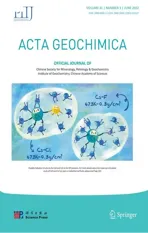Organic geochemistry characteristics of Jurassic black shales from the Amdo area,northern Tibet,China
2022-07-11GuiwenXuLanChenWeiguangZhuXuejuanDaZhangxiongZhuHaishengYi
Guiwen Xu·Lan Chen·Weiguang Zhu·Xuejuan Da·Zhangxiong Zhu·Haisheng Yi
Abstract The Jurassic black shales of the Qiangtang Basin,northern Tibet are known to be amongst the most important source rocks.To date,there is no detailed study on the organic geochemistry of the Bathonian/Callovian coccolith-bearing sediments and their source-rock characteristics.Here,we focus on the black limestones,marls,and shales at the Amdo 114 station section using Rock-Eval pyrolysis and biomarkers for sources,types,and thermal maturity of organic matter and the reconstructed depositional environment.All samples are characterized by(1)relatively high TOC values(0.20-2.56 wt%)and relatively low Tmax values between 428 and 452°C;(2)shortchain n-alkanes with a maximum at C14 to C18 and Pr/Ph>1;(3)31-35 homohopanes and gammacerane with lower abundance;and(4)C27-C28-C29 regular steranes with C29 being slightly dominant.The organic matter is Type II and thus dominantly derived from phytoplankton,especially algae.Thermal maturity indicators include the Ts/(Ts+Tm), C31 22S/(22S+2R), C29 ααα20S/(20S+0R),C29ββ/(ββ+αα)and C27 Dia/(Dia+Reg),which are regarded as immature to very early mature.Additionally,the high Pr/Ph,Pr/nC17,and Ph/nC18 ratios,Pr/Ph vs Gammacerane index suggest that these black shales were deposited in unstratified marine waters of normal salinity under dysoxic to weakly reduced conditions.
Keywords Rock-Eval pyrolysis·Biomarkers·Source rocks·Jurassic·Northern Tibet
1 Introduction
The marine Jurassic sedimentary successions of the Qiangtang Basin,northern Tibet(China)are well known for their organic carbon-rich shales,abundant fossil content,and the very complete and expanded sections,especially for the Middle to Upper Jurassic strata(Chen et al.2003,2014).These Jurassic sediments have been viewed as important exploration targets by numerous petroleum geologists(Chen et al.2014;Wu et al.2016).However,a precise understanding of their stratigraphic age,depositional environment,and prevailing palaeo-environmental conditions has been under debate for several decades.Furthermore,the Jurassic strata that contain poorly preserved ammonites,typically squashed flat,are particularly difficult to date.Nevertheless,two Jurassic sections(Biluo Co and Amdo 114 station)in northern Tibet have proven to be relatively rich in coccoliths(Chen et al.2003),and have recently been dated to the Middle Jurassic,Bathonian to Callovian(Chen et al.2016,2019).However,there has been no detailed focus on the organic geochemistry of these coccolith-bearing samples to document the palaeoenvironmental changes across the Bathonian to Callovian boundary.The Biluo Co section exposes organic-rich black shales(also called oil shales in the literature),known to be important petroleum source rocks in this area (Chen et al.2016,2017).However,the biomarkers at the Amdo 114 station section are poorly understood and few studies have investigated the calcareous nannofossil-rich samples for organic geochemical data to address the relevant palaeo-environmental evolution.
The aim of this study is thus to discuss the palaeo-environmental changes that occurred across the Bathonian to Callovian boundary at the Amdo 114 station section,Qiangtang Basin(northern Tibet,China)integrating Rock-Eval pyrolysis and biomarkers.Based on the organicmatter characteristics,Rock-Eval pyrolysis,and biomarkers,this study gives further insight into the sources and types of organic matter,its thermal maturity,palaeoenvironmental changes during deposition and helps evaluate the hydrocarbon potential of the Qiangtang Basin,Tibet.
2 Geological setting
The Qiangtang block in northern Tibet is sandwiched between the Jinsha suture zone(JSSZ)in the north and the Bangong-Nujiang suture zone(BNSZ)in the south(Fig.1)(Zhu et al.2016;Zhang et al.2017).The northern Qiangtang block is primarily covered by Upper Triassic-Upper Jurassic intercalated marine siliciclastic rocks and limestones,with Carboniferous-Permian shelf strata exposed at its easternmost margin,whereas the southern Qiangtang block contains Carboniferous-Permian shelf-sea sediments,with Triassic-Jurassic marine rocks exposed at its northern and southern limbs(GSC and CIGMR 2013;Zhang et al.2017).
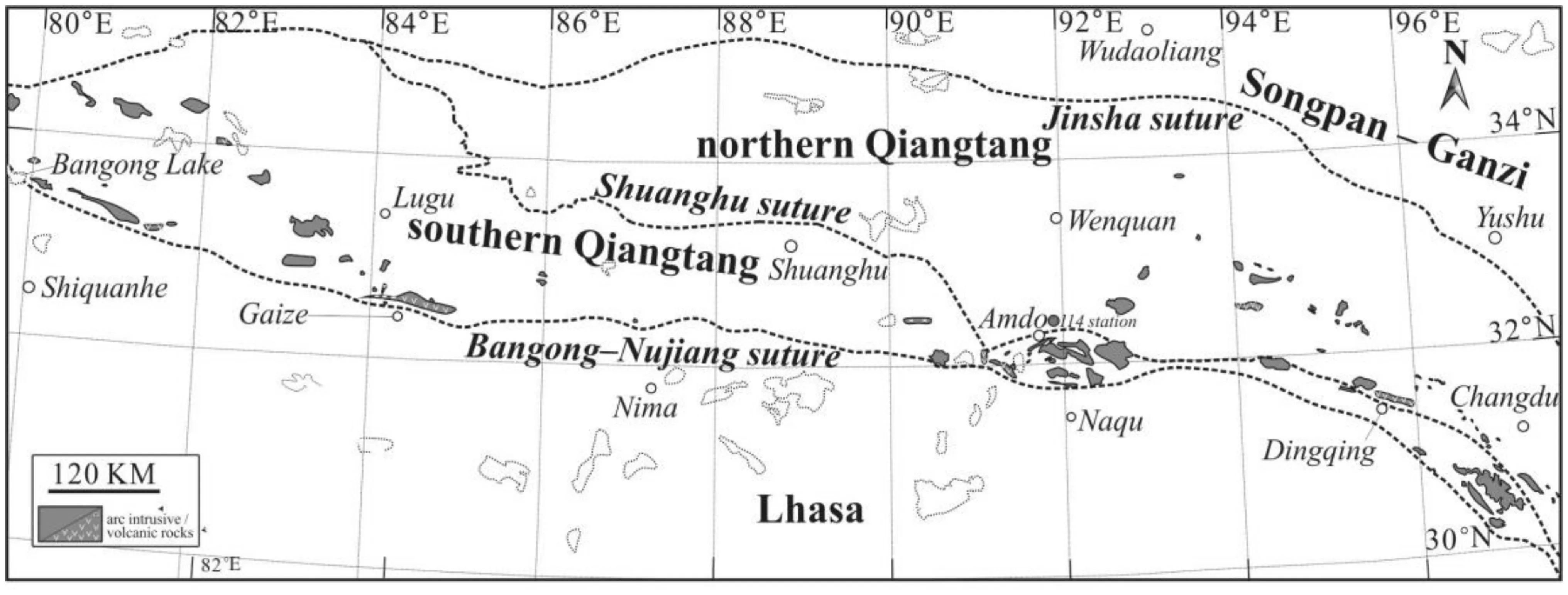
Fig.1 Simplified tectonic map of the Qiangtang Basin and the studied area(simplified after Zhang et al.2012,2017;GSC and CIGMR 2013.Amdo is also spelled as Ando sor Anduo.)
The Amdo 114 station section is located in the southern Qaingtang block with well-exposed Jurassic sediments,and many geologists have undertaken fieldwork in this area with a focus on petroleum geology or regional investigations.The lower part of this section is composed of conglomerates,sandstones,and siltstones,whereas the middle part is made up of bioclastic limestones and silty limestones.The upper part of the section is characterized by grey-green siltstones,calcareous fine-grained sandstones,dark grey,medium-thick bedded microcrystalline limestones,medium to thin-bedded marls with bioclastic interbeds,and clay-rich and/or silty limestones(Fig.4 of Chen et al.2019).Furthermore,the section has provided some molluscs of the Jurassic age(Chen et al.2006),including the bivalve generaBuchia,Chlamys,Posidonia(Bositra)plus some significant ammonites whose stratigraphical ages have proven controversial.The age range ofBositrais fixed as Toarcian to Oxfordian(Jefferies and Minton 1965).Additionally,Chen et al.(2016,2019)found more samples with calcareous nannofossil and provided new data.The presence,from the base of the section,ofWatznaueria barnesiaesuggests at least a Bathonian age;from sample AD-21-1,W.barnesiaebecomes abundant and the presence in sample AD-16-5 ofCyclagelosphaera wiedmanniisuggests at least the latter part of the stage(Mattioli and Erba 1999).Also in this section,the range ofAnsulasphaera helveticaallows the identification of the NJ12 Zone,which spans the interval from the upper Bathonian to the Callovian(Figs.4 and 6 of Chen et al.2019).
3 Analytical method
3.1 Rock-Eval pyrolysis analyses
Thirteen samples from Amdo 114 station are mainly limestones,marls,and shales.Ten samples contained coccoliths,and 3 samples(AD-5-2,AD-12-1,and AD-34-2)were barren.To obtain information on the type and thermal maturity of the bulk organic matter,Rock-Eval analyses were performed on 13 samples with a Rock-Eval device(Vinci Technologies)under standard conditions(see all details about Rock-Eval pyrolysis and parameters in Espitalie´1993;Behar et al.2001).Measurements made include S1(mg HC/g rock),S2(mg HC/g rock)and Tmax(°C).Derived parameters such as the Total Organic Carbon(TOC)content(wt%),the Hydrogen Index(HI=S2/TOC×100;mg HC/g TOC)were also determined.
3.2 Biomarkers analyses
Thirteen samples were crushed to 80 mesh and Soxletextracted over 72 h with Dichloromethane(DCM)and Methanol(MeOH)(93:7,v/v).Total lipid extracts were concentrated and diluted inn-hexane for 24 h to precipitate asphaltenes.The other extracts were then separated into three fractions by alumina/silica gel column chromatography usingn-hexane to elute the saturated hydrocarbons,DCM:n-hexane(2:1,v/v)for the aromatic hydrocarbons,and DCM:MeOH(93:7,v/v)for the polar fraction.The gas chromatography-mass spectrometry(GC-MS)analyses of the saturated fraction were performed on a Shimadzu QP2010plus gas chromatography and an Agilent 5977B mass spectrometer equipped with an HP-5 MS fused silica capillary column(60 m×0.25 mm inner diameter with a 0.25μm film coating).The initial GC oven temperature was 50°C(hold 1 min),and then increased to 120°C at 20°C/min,and finally increased to 310°C at 3°C/min(hold 25 min).The mass spectrometer was operated in fullscan mode with an electron impact ionization mode at 70 eV.Selective detection of hopanes and steranes was realized by ion extraction(191 and 217,respectively).All experiments were carried out in the National Research Center of Geoanalysis,China.
4 Results
4.1 TOC and Rock-Eval pyrolysis
TOC contents varied between 0.20 and 2.56 wt%(1.06 wt% on average),especially those coccoliths-bearing samples with relatively high TOC contents(>0.5 wt%)(Table 1).Rock-Eval S1 and S2 contents fall into the ranges of 0.01 and 0.57 mg HC/g rock,and 0.05 and 9.18 mg HC/g rock,respectively.The HI values range from 50 to 394 mg HC/g TOC.Tmax values vary between 428 and 452°C,with an average of 435°C.The plot of HI vs Tmax indicates that the organic matter is immature to early mature and has undergone only minor thermal diagenesis(Fig.2).The organic matter is of Type II.

Fig.2 The plot of HI(mgHC/gTOC)VS.Tmax(°C)indicates that the organic matter is immature to oil window.The boundary lines that denote the different kerogen types are referred to Espitalie´et al.(1986)
4.2 Biomarkers
The bitumen contents are relatively low,lying within the range of 0.0205 to 0.1273% (Table 1),and the extractable hydrocarbons consisted mainly of saturated and polar compounds,with generally high saturate/aromatic ratios(>1.0,except for three samples with ratios of 0.6 and 0.8;Table 1).
4.2.1 n-Alkanes and isoprenoids
The C11-C35n-alkanes are present in the total ion chromatograms(TIC)of the saturated hydrocarbon fractions(Fig.3),which displays a clear dominance of short-chain(nC11-nC19)relative to long-chainn-alkanes(nC27-nC35)with a maximum atnC14tonC18.The values of the carbon preference index(CPI),and odd-to-even predominance(OEP),are in the range of 0.92-1.21 and 0.84-1.13,respectively(Table 1).
All samples have higher concentrations of pristine(Pr)than phytane(Ph)under GC-MS full-scan analyses and strongly varied ratios of the Pr/Ph and isoprenoid/n-alkane(Table 1).The Pr/Ph,Pr/nC17and Ph/nC18ratios range from 1.27 to 3.41,0.60 to 1.13,and 0.31 to 0.51,respectively(Table 1).
4.2.2 Terpanes
The m/z 191 mass chromatogram showed the presence of the C27to C3517α(H),21β(H)-hopanes,especially the C30-hopane as the most prominent hopane peak in all samples,while the tri-and tetra-cyclic terpanes are absent(Fig.4).The C27hopanes are represented by the 17α(H)-22,29,30-trinorhopane(Tm)and the 18α(H)-22,29,30-trinorneohopane(Ts).Furthermore,the pentacyclic terpanes show C31to C35homohopanes,however,from C31homohopane onwards, the homohopanes gradually decrease in abundance,and the C33,C34,or C35homologues occur in low concentrations.
The 22S/(22S+22R)C31homohopane ratios have reached the equilibrium with values of about 0.6,followed by 0.57-0.66.Furthermore,the Ts/(Ts+Tm)C27hopane diastereomer values fluctuate from 0.16 to 0.46(except for a value of 0.60 from sample AD-16-2)(Table 2),showing a higher abundance of the thermally less stable trisnorhopane(Tm)than trisnorneohopane(Ts).This pattern corresponds to relatively low thermal maturity levels.Additionally,gammacerane identified in the m/z 191 chromatograms(Fig.4)shows very low concentrations and the gammacerane/(gammacerane+αβC30 hopane)index(Sinninghe´-Damste´et al.1995)ranges from 0.01 to 0.06(Table 2).

Table1BasicgeochemicaldataoftheJurassicblackrockseriesatAmdo114stationsection,northernTibet OEP CPI Ph/C18 Pr/nC17 Pr/Ph-/ΣC21 ΣC22+Maximumpeak carbon RHP HI TOC(wt%)Tmax(°C)S2(mg/g)S1(mg/g)Saturates/aromatics Extractablehydrocarbons(wt%)Lithology Sample no 0.95 1.11 0.98 1.07 0.91 0.99 0.99 1.13 0.99 0.94 0.84 0.86 1.03 0.98 1.21 1.03 1.17 0.96 1.12 1.05 1.17 1.08 0.98 1.14 0.92 1.13 0.51 0.49 0.47 0.51 0.47 0.45 0.48 0.35 0.41 0.32 0.48 0.31 0.39 0.76 1.13 0.89 1.09 0.87 0.99 1.03 1.06 0.91 0.61 0.76 0.60 0.77 1.27 2.42 2.03 2.41 2.45 1.99 2.17 3.41 2.20 2.16 1.47 1.91 1.89 1.43 2.98 1.65 4.29 2.98 1.68 2.89 4.23 2.65 7.82 2.78 1.60 3.29 nC18 nC17 nC16 nC15 nC16 nC17 nC16 nC14 nC14 nC16 nC17 nC16 nC16 1.90 4.14 4.12 1.54 3.08 1.56 2.36 2.09 1.22 0.95 0.81 1.63 0.60 171 394 391 137 285 140 218 197 106 74 69 147 50 0.41 2.33 1.99 0.54 2.51 0.57 1.24 1.29 0.49 0.19 0.16 0.57 0.1 428 429 429 434 427 437 431 437 435 436 445 432 452 0.7 9.18 7.79 0.74 7.16 0.8 2.7 2.54 0.52 0.14 0.11 0.84 0.05 0.08 0.46 0.41 0.09 0.57 0.09 0.23 0.16 0.08 0.04 0.02 0.09 0.01 39.0 1.0 1.2 1.4 0.8 6.6 1.1 0.8 2.9 10.0 0.6 2.5 7.6 0.0463 0.1273 0.1100 0.0329 0.0998 0.0388 0.0574 0.0475 0.0298 0.0235 0.0205 0.0445 0.0275 Limestone Marl Shale Marl Shale Marl Marl Mudstone Shale Limestone Limestone Shale Mudstone AD-34-2 AD-31-1 AD-30-2 AD-28-1 AD-27-2 AD-25-1 AD-23-f1 AD-22-1 AD-17-1 AD-16-2 AD-15-1 AD-12-1 AD-5-2(mgHC/gTOC),CPI carbonpreferenceindex=((C23+C25+C27+C29)/(C22+C24+C26-C25)/(4C22+4C24)(ScalanandSmith1970)HI hydrogenindex(mgHC/gTOC),RHP relativehydrocarbonpotential=(S1+S2)/TOC(C23+C25+C27+C39)/(C24+C26+C28+C30))/2(BrayandEvans1961),OEP oddorevenpreference=(C21+6C23++C28)+
4.2.3 Steranes
According to the m/z 217 mass chromatogram(Fig.5),the C27to C29regular steranes are predominant,the rearranged C27-C29diaster-13(17)-enes are present,but the C21and C22pregnanes are lacking.Distribution of the C27to C29regular steranes indicated an only slight preference for either C27or C29steranes,which is similar to the Ediacaran-Lower Cambrian source rocks from the Sichuan Basin(South China)(Cheng et al.2018),but is significantly different from Jurassic samples of the Yanshiping area(Northern Tibet)(Chen et al.2014).The ratios C29ααα 20S/(20S+20R)vary between 0.35 and 0.47(Table 2),which is below the thermal equilibrium of 0.52-0.55 at about a value of 0.8 for vitrinite reflectance(Peters et al.2005).The C29ββ/(αα+ββ)ratios have relatively stable values of about 0.27-0.41,and the C27diasteranes/(diasteranes+regular steranes) ratios of 0.38-0.48(Table 2).
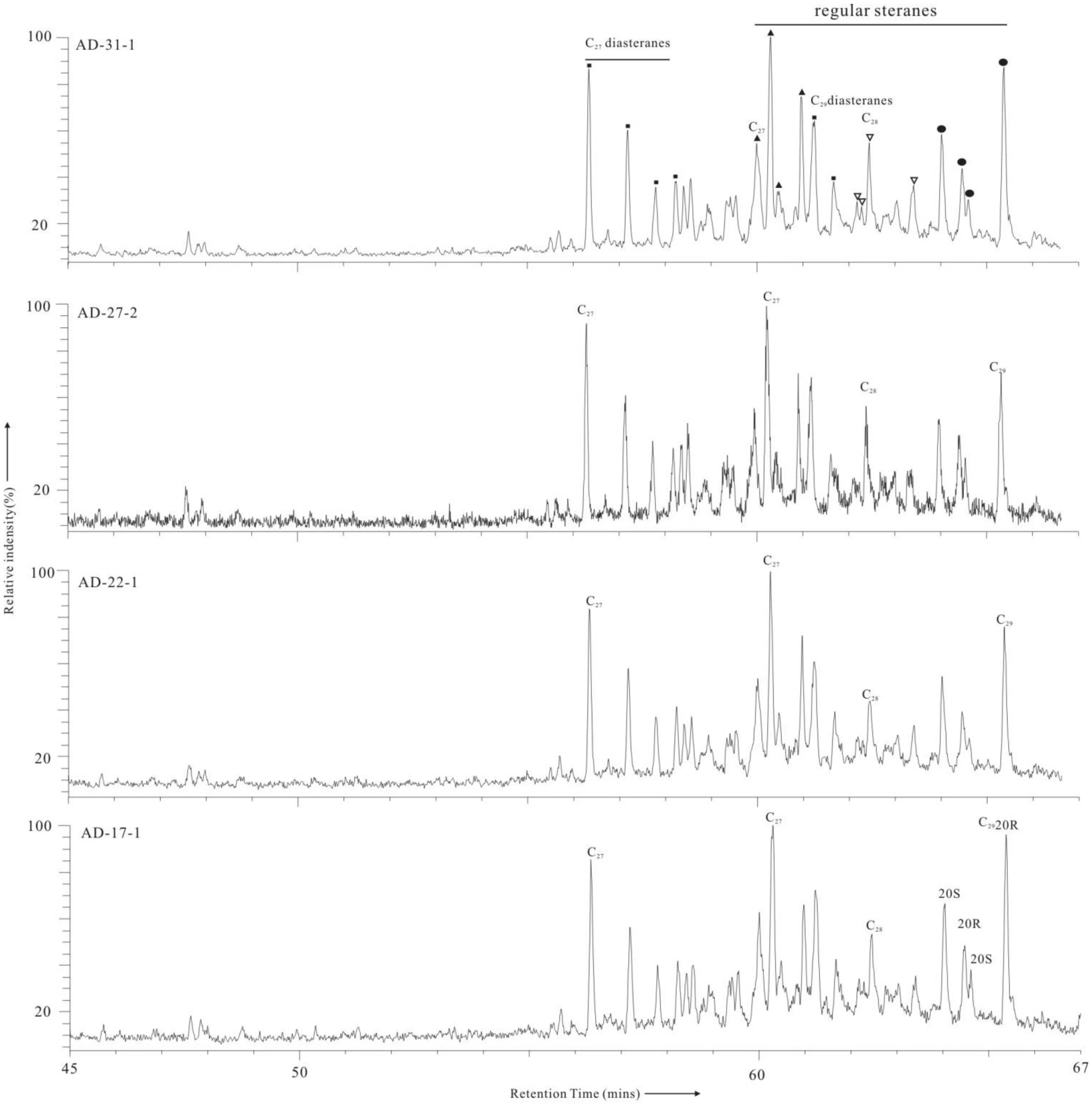
Fig.5 The m/z 217 chromatograms showing relative abundance of steriods in the selected samples.The 20S and 20R epimers are shown for C29 regular steranes
5 Discussion
Generally speaking,biomarkers can be used to discuss sources,types,and maturities of organic matters,even certain environments of sedimentary rocks,especially organic-carbon-rich black shales(Peters et al.2005;Song et al.2017;Aderoju and Bend 2018;Xu et al.2019).
5.1 Sources of organic matter
Based on then-alkane distributions,it can be distinguished the origin of the organic matter in terms of terrestrial versus marine(Quijano et al.2012).All studied samples from Amdo 114 station are characterized by short-chainnalkanes(<nC20),which indicates algal,phytoplankton,and bacteria sources.However,the medium-chainn-alkanes(nC21-nC25)also occurred(Fig.3),which originate from vascular plants,microalgae,cyanobacteria,Sphagnumspp.,and aquatic macrophytes(Bingham et al.2010).In addition,Table 1 shows the CPI and OEP values of 0.92 to 1.21 and 0.84 to 1.13,respectively.

Fig.3 Total ion Chromatograms(TICs)of the selected samples from Amdo 114 station,Qiangtang Basin(Tibet,China).Numbers above symbols denote carbon numbers
The hopanoids have been widely proposed to derive from the bacteriohopanetertrol and 3-desoxyhopanes,which are present in prokaryotic organisms(i.e.bacteria)and fungi(Bechtel et al.2001).Summons et al.(1999)suggested that the C30to C35homologues with 22S/Risomers of 17α(H),21(β)-homohopanes are sourced by cyanobacteria.Fig.4 indicates a series of 17α(H),21(β)-homohopanes(C27-C29tricyclic terpanes and C30-C35hopanes)with relatively high abundances in all samples,which indicate significant bacterial input to the sources of organic matter.However,gammacerane is in very low abundance in these samples.Although it is not a bacterial compound,gammacerane typically occurs when bacteria are present in the water column(Sinninghe´-Damste´et al.1995;Rashby et al.2007).
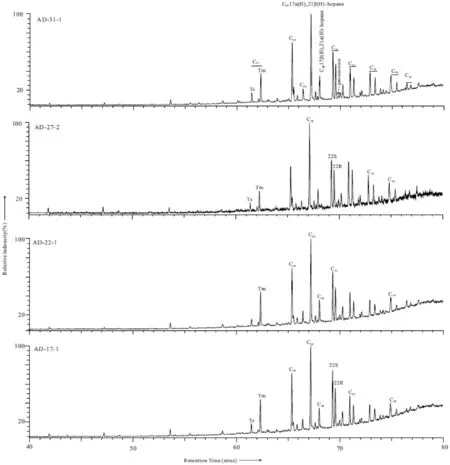
Fig.4 The m/z 191 chromatograms showing relative abundance of terpenoids in the selected samples.Ts,18α(H)-22,29,30-trisnorneohopane;Tm,17α(H)-22,29,30-trisnorneohopane.The 22S and 22R epimers are shown for C31-homohopanes
By comparison,steranes are formed from precursor sterols,which are detected in all eukaryotes(i.e.algae,higher plants)but rarely in prokaryotes(Bechtel et al.2001).The relative abundances of C27,C28,and C29steranes are shown in Table 2 and plotted in Fig.6,but 9 samples are lacking C28regular steranes.All samples are characterized by lower C27/C29ratios from 0.47 to 0.81,and the C28/C29ratios of 4 samples are<0.36.The distribution of C27-C28-C29regular steranes are shown in a ternary plot with C29always being dominant(47.3-65.6%),C27intermediate(29.5-44.7%),and C28minor(16.1-19.6%)(Fig.6).The relative distributions of C27-C28-C29regular steranes are similar,but considerable variability within that proportionality is present.Moreover,the data points suggested that the steranes were mainly derived from terrestrial plants.However,the C29steranes could also come from microalgae.Therefore,our studied samples indicate a relatively high contribution of phytoplankton,especially algae,as the primary source.
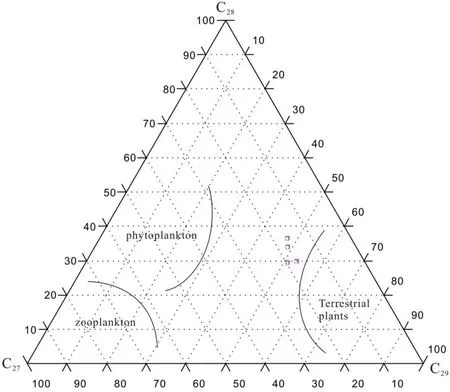
Fig.6 Relative composition of C27,C28 and C29 steranes from the studied samples showing the organic matter stems mainly from phytoplankton
Importantly,the nannoflora indicate an increase in trophic level in the higher part of the sections,being a similar phenomenon to that observed in Callovian-Oxfordian Tethyan strata and implying a regional if not a global palaeoceanographic phenomenon that locally-led to the deposition of organic-rich black shales(Chen et al.2019).
5.2 Thermal maturity trends
Biomarkers,as indicators of the thermal history of organic matter,can be used and have been applied to source rocks,oils(including tars,biodegraded oils,etc.),and even to fluids produced from very young sediments affected by hydrothermal activity(Peters et al.2005;Blumenberg et al.2012;Sachse et al.2012).Molecular indicators of thermal maturity by sterane isomerization generally include the C29ααα20S/(20S+20R),C29ββ/(ββ+αα)and C27Dia/(Dia+Reg).A cross-plot of C29ααα20S/(20S+20R)vsC29ββ/(ββ+αα)sterane ratios is particularly effective in assessing thermal maturity(Fig.7a;Peters et al.2005).In general,the equilibrium at a value of ca.0.55 of the C29ααα20S/(20S+20R)ratios corresponds to about 0.8%VRr.In addition,the C29ββ/(ββ+αα)ratios increase with thermal maturity to~0.7(0.67-0.71=equilibrium)at about 0.9%VRr(Peters et al.,2005).In the studied section,steranes are characterized byββ/(ββ+αα)ratios between 0.27 and 0.41,20S/(20S+20R)between 0.35 and 0.47,and C27Dia/(Dia+Reg)between 0.38 and 0.48,respectively(Table 2 and Fig.7).These values,rather invariable and far away from the equilibrium area,are regarded as immature to very early mature indicators for petroleum generation.

Fig.7 Maturity-related biomarker parameters by sterane isomerization.a C29ααα20S/(20S+20R)vs.C29ββ/(ββ+αα).b C29ααα20S/(20S+20R)vs.C27 diasterane/(diasterane+regular sterane)
Transformation of the biologically produced 22R form of the C31-C35extended 17α(H)-hopanes to the 22S epimer is illustrated in Fig.0.4.The m/z 191 mass chromatograms show the changes in proportions of C-22 epimers with increasing maturity.At equilibrium,the approximate proportions are 55-60%22S and 40-45%22R(Waples and Machihara, 1991). Therefore, the ratios of 22S/(22S+22R)homohopane are also regarded as maturity indicators.The studied samples showed ratios of 22S/(22S+22R)from 0.57 to 0.66,close to the equilibrium,whereas high values can also occur in hypersaline depositional environments(ten Haven et al.1987).With increasing maturity,the 17α-22,29,30-trisnorneohopane(Tm)gradually disappears and the 18α-22,29,30-trisnorneohopane(Ts)increases in relative concentration.In practice,however,Ts/(Ts+Tm) ratios should be influenced by facies,salinity,and redox conditions as well as maturity(Peters et al.2005).All samples from Amdo 114 station show lower Ts/(Ts+m)ratios from 0.16 to 0.60.Additionally,Tmax values change between 427 and 452°C,and the plot of HI/Tmax indicates that the OM is immature to the oil window(Fig.2).The above-shown data indicate that the Middle Jurassic sediments from Amdo 114 station section are immature to early mature concerning oil generation.This interpretation is also consistent with those parameters shown in Fig.8.
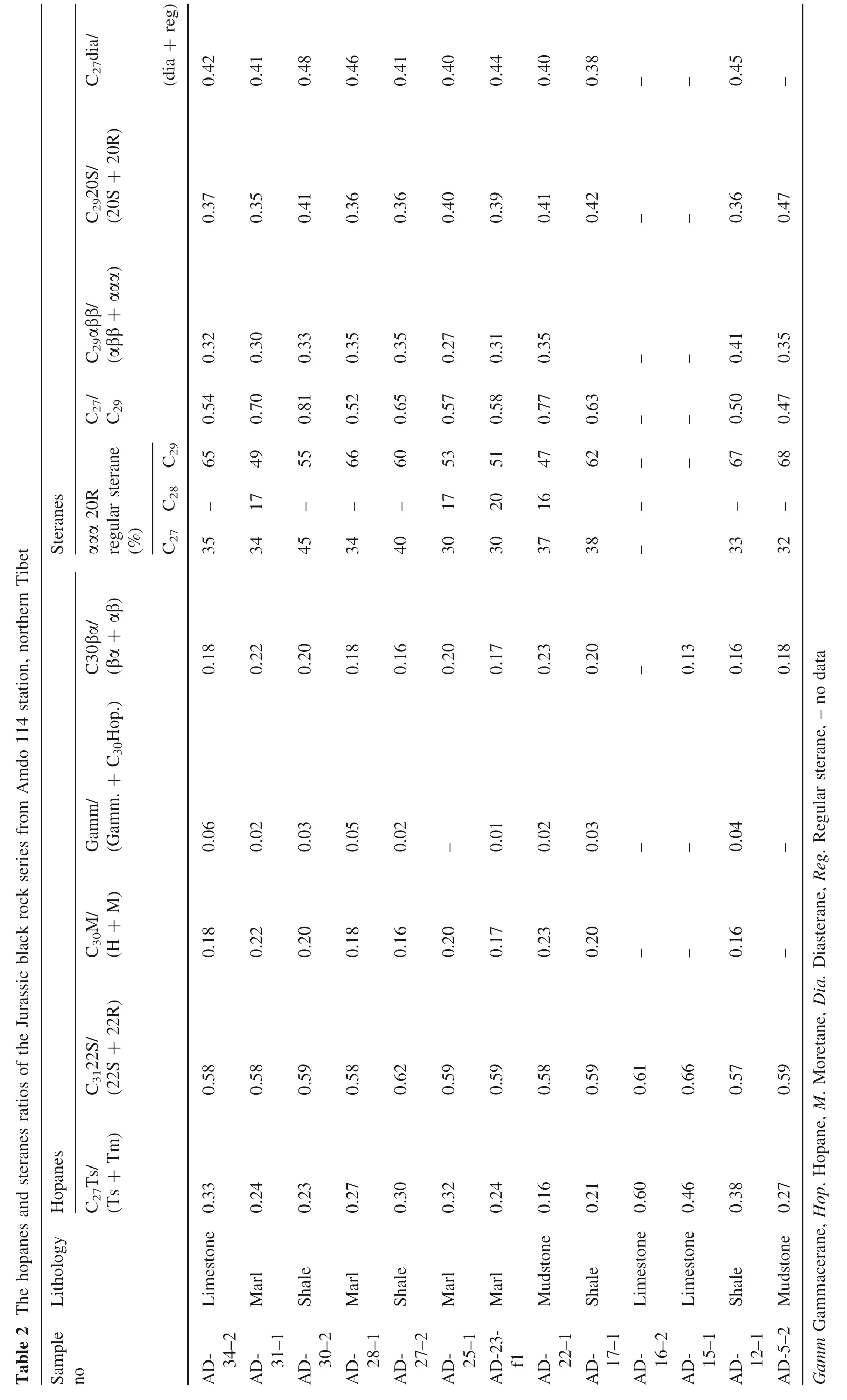
C27dia/(dia+reg)0.42 0.41 0.48 0.46 0.41 0.40 0.44 0.40 0.38--0.45-C2920S/(20S+20R)0.37 0.35 0.41 0.36 0.36 0.40 0.39 0.41 0.42--0.36 0.47 C29αββ/(αββ+ααα)0.32 0.30 0.33 0.35 0.35 0.27 0.31 0.35--0.41 0.35 C27/C29 0.54 0.70 0.81 0.52 0.65 0.57 0.58 0.77 0.63--0.50 0.47 Table2ThehopanesandsteranesratiosoftheJurassicblackrockseriesfromAmdo114station,northernTibet Steranes ααα20R regularsterane(%)C30βα/αβ)(βα+Gamm/(Gamm.+C30Hop.)C30M/+M)(H C3122S/(22S+22R)Hopanes C27Ts/Tm)(Ts+Lithology Sample no C29 C28 C27 65 49 55 66 60 53 51 47 62--67 68-17---17 20 16---35 34 45 34 40 30 30 37 38-33 32 0.18 0.22 0.20 0.18 0.16 0.20 0.17 0.23 0.20-0.13 0.16 0.18 0.06 0.02 0.03 0.05 0.02-0.01 0.02 0.03--0.04-0.18 0.22 0.20 0.18 0.16 0.20 0.17 0.23 0.20--0.16-0.58 0.58 0.59 0.58 0.62 0.59 0.59 0.58 0.59 0.61 0.66 0.57 0.59 0.33 0.24 0.23 0.27 0.30 0.32 0.24 0.16 0.21 0.60 0.46 0.38 0.27 Limestone Marl Shale Marl Shale Marl Marl Mudstone Shale Limestone Limestone Shale Mudstone AD-34-2 AD-31-1 AD-30-2 AD-28-1 AD-27-2 AD-25-1 AD-23-f1 AD-22-1 AD-17-1 AD-16-2 AD-15-1 AD-12-1 AD-5-2 Gamm Gammacerane,Hop.Hopane,M.Moretane,Dia.Diasterane,Reg.Regularsterane,-nodata
5.3 Redox conditions
The Pr/Ph ratio has been used to infer depositional redox conditions but is also influenced by several other factors(e.g.thermal maturity,variable biomolecule sources,lithology,and diagenetic effects)(Peters et al.2005).In general,the high Pr/Ph ratios(>1.27)indicate oxidizing depositional conditions(>0.8;Hughes et al.1995).Fig.8 showed the high Pr/nC17and Ph/nC18ratios,however,all samples are characterized by dark colors,lamination,and calcareous nannofossils.Therefore,all samples indicated dysoxic to weakly reduced bottom waters.

Fig.8 Pr/nC17 vs.Ph/nC plot for all samples indicating deposition under oxidizing to oxygen-depleted conditions.The reference lines are from Didyck et al.(1978)
In addition,high ratios of C30moretane/(moretane+hopane),22S/(22S+22R)C31homohopane and Ts/(Ts+Tm),as well as high gammacerane contents and gammacerane index[gammacerane/(gammacerane+C30-Hopane)],are considered to be markers for the enhanced water salinity and water-column stratification(commonly resulting from hypersalinity at depth)(Sinninghe Damste´et al.1995;Peters et al.2005;Song et al.2017;Aderoju and Bend 2018).All samples from Amdo 114 station section are characterized by gammacerane with low abundance(Fig.4),a gammacerane index with low values in the range of 0.02-0.10(Table 2),and Ts/(Ts+Tm)ratios between 0.16 and 0.46(except for 0.60 of sample AD-16-2)(Fig.9a,d),but the C30Moretane/(Moretane+Hopane)and Pr/Ph with high ratios(Fig.9b,c).Together,these organic geochemical data suggest normal marine salinity,redox conditions varying from dysoxic to weakly reduced,and an absence of water-column stratification during deposition of the Middle Jurassic black shales in Tibet.

Fig.9 Molecular indicators of Water salinity by Pr,Ph,and hopanes,and steranes.a Ts/(Ts+Tm)vs.C30 hopane/(Hopane+Moretane),b gammacerane index vs.C30 Moretane/(Hopane+Moretane),c gammacerane index vs.Pr/Ph and d Ts/(Ts+Tm)vs.22S/(22S+22R)C31 Homohopane ratios for selected samples from Amdo 114 station,Qiangtang Basin(Tibet,China)
6 Conclusions
All samples containing abundant organic matter from Amdo 114 station,northern Tibet were investigated for Rock-Eval pyrolysis and biomarker compositions.Those samples with abundant coccoliths and relatively elevated TOC,dated as Bathonian/Callovian,are shown to have organic matter derived mainly from phytoplankton or algae.Redox conditions in the depositional environment varied from dysoxic to weakly reduced,salinity was normal,and there is no evidence for a stratified water column.Maturity-related biomarkers and S1,S2,and HI indicate that all samples in the studied area were immature or of early oil window maturity.According to organic geochemical parameters,these Middle Jurassic source rocks from the Qiangtang Basin(northern Tibet,China)are characterized by a relatively elevated abundance of organic matter,type II kerogens,and modest thermal maturity,which suggests that the Qiangtang Basin has favorable petroleum potential.
AcknowledgementsWe would like to thank Minquan Xia,Maocheng Wang for their fieldwork.Many thanks are also given to Mrs.Sun Weiling for the Organic geochemistry experiments at the National Research Center of Geoanalysis(Beijing,China).This study was supported by the National Natural Science Foundation of China(Grants Nos.41572095,42172121,41102066,and 41572089)and the Opening Foundation of the State Key Laboratory of Marine Geology,Tongji University(China)(Grant No.MGK1703).Hugh Jenkyns(University of Oxford,UK)helped with the English language and style.We are grateful to Editor Dr.Binbin Wang and anonymous reviewers for their constructive comments and suggestions on this manuscript.
Declarations
Conflict of interestOn behalf of all authors,the corresponding author states that there is no conflict of interest.
杂志排行
Acta Geochimica的其它文章
- A molecular simulation study of Cs-Cl and Cs-F ion pairs in hydrothermal fluids
- Hydrocarbon distribution along the Soapaga thrust(Eastern Cordillera,Colombia)based on new strategic geochemistry samples
- Genesis and magma fertility of gold associated high-K granites:LA-ICP-MS zircon trace element and REEs constraint from Bakoshi-Gadanya granites in NW Nigeria
- Use ofδ18O,δ13C and NO3-to identify hydrogeochemical processes related to contamination in an aquifer located in central Mexico
- Using zircon saturation thermometry of source magma in strongly altered volcanic ashes
- Rare earth element(REE)geochemistry of different colored fluorites from the Baoshan Cu-Pb-Zn deposit,Southern Hunan,South China
